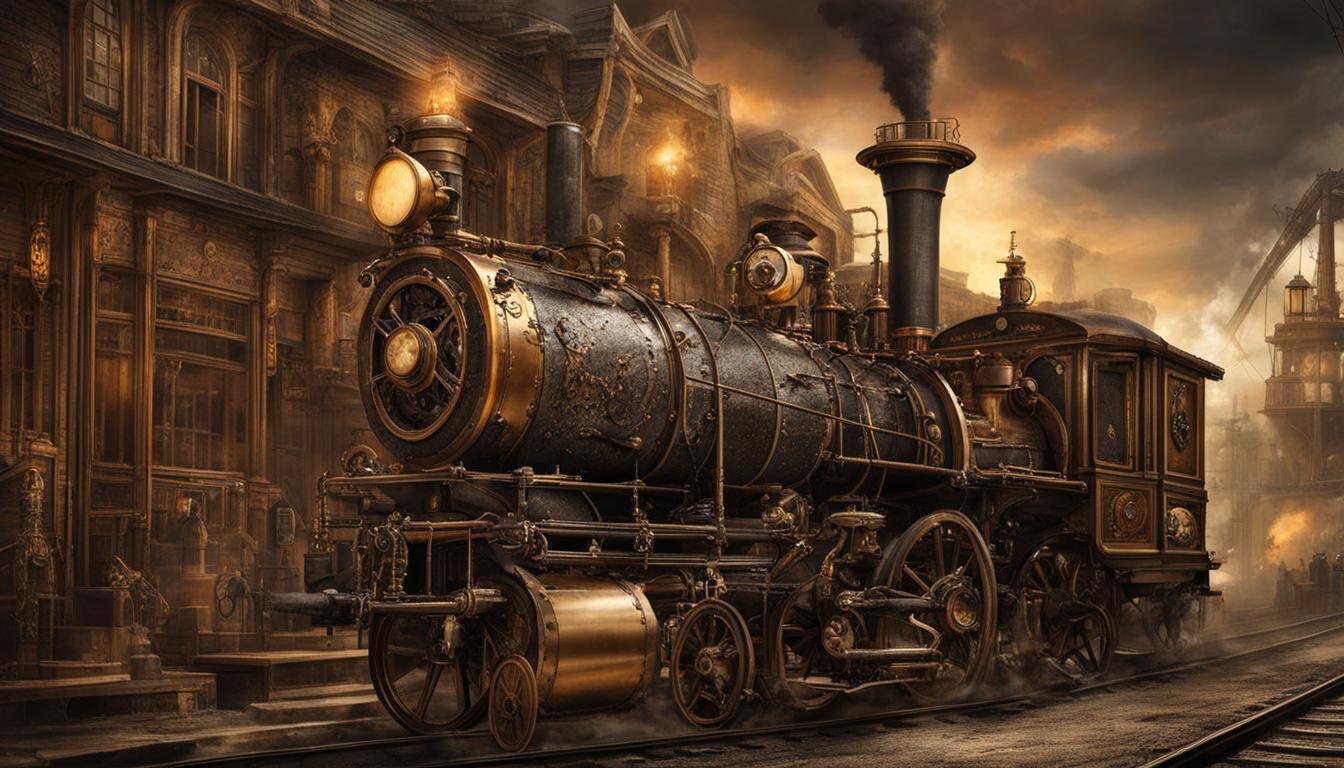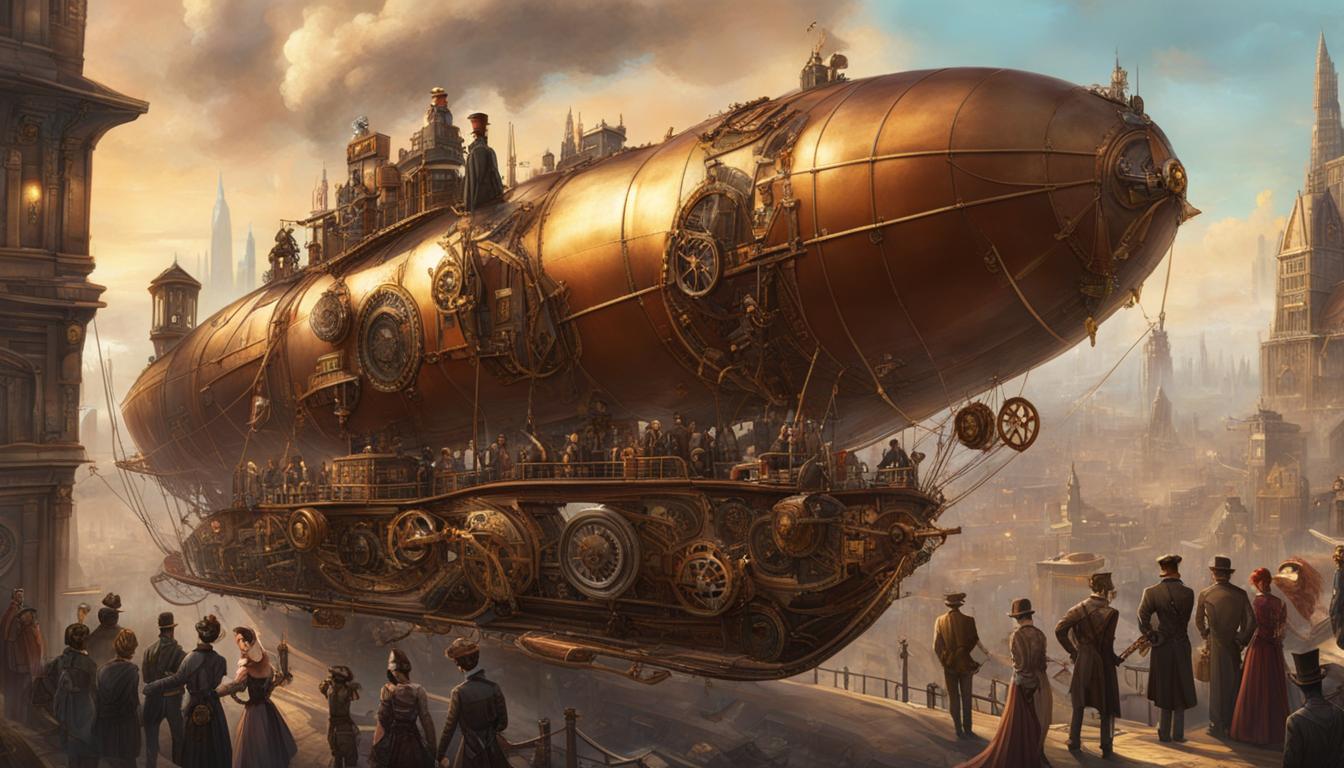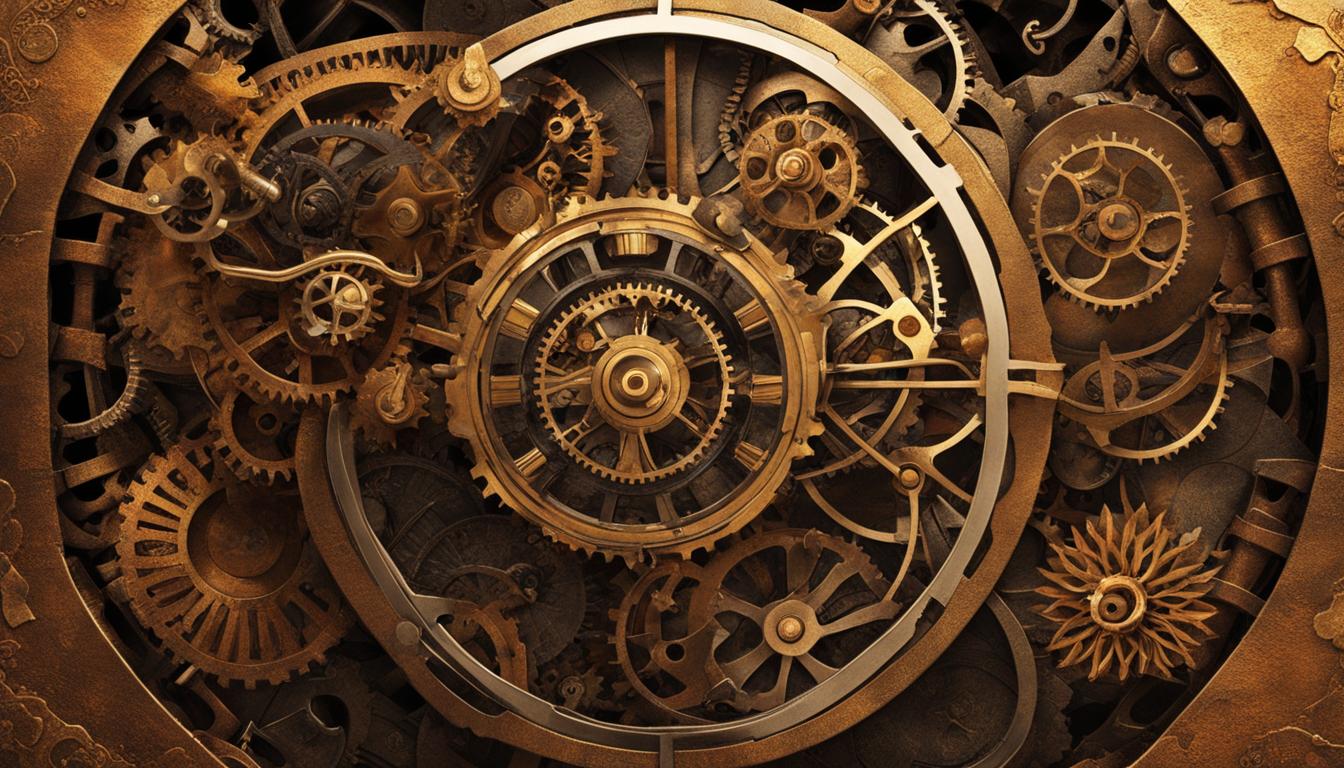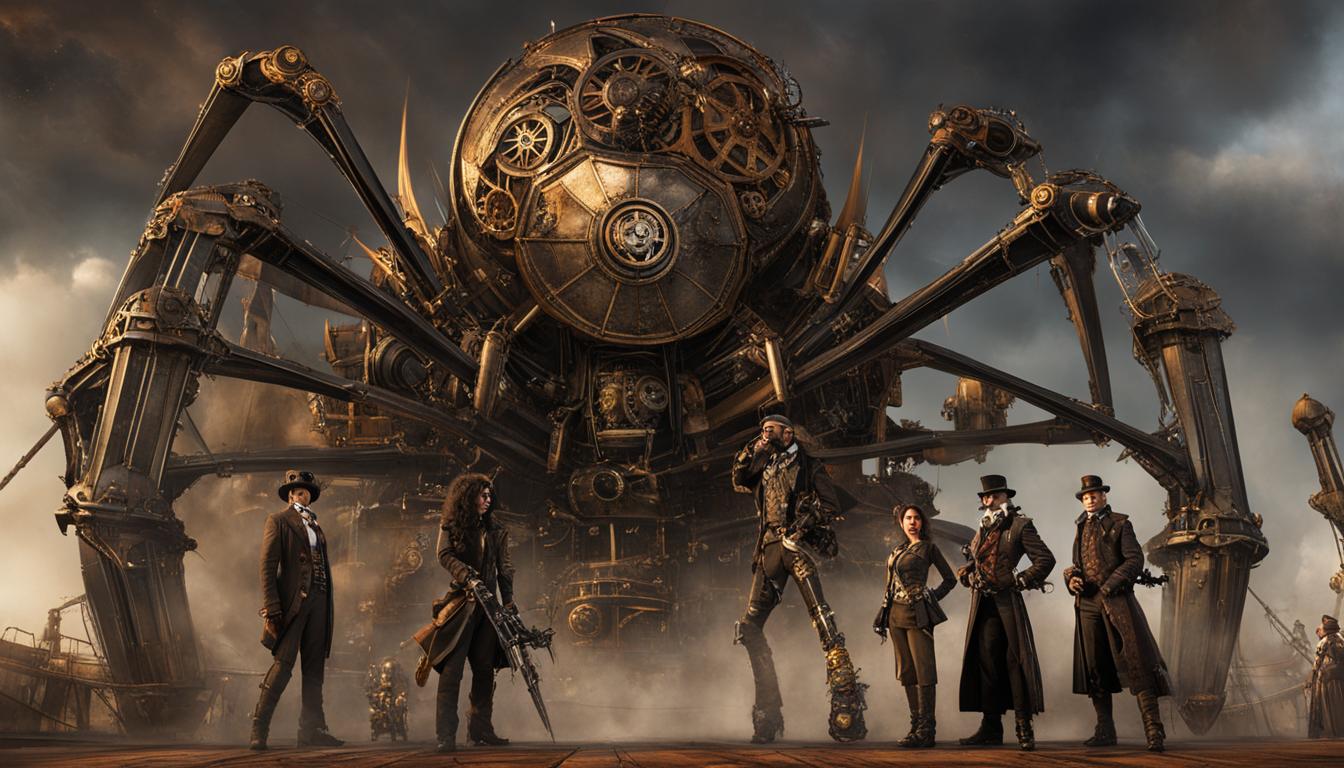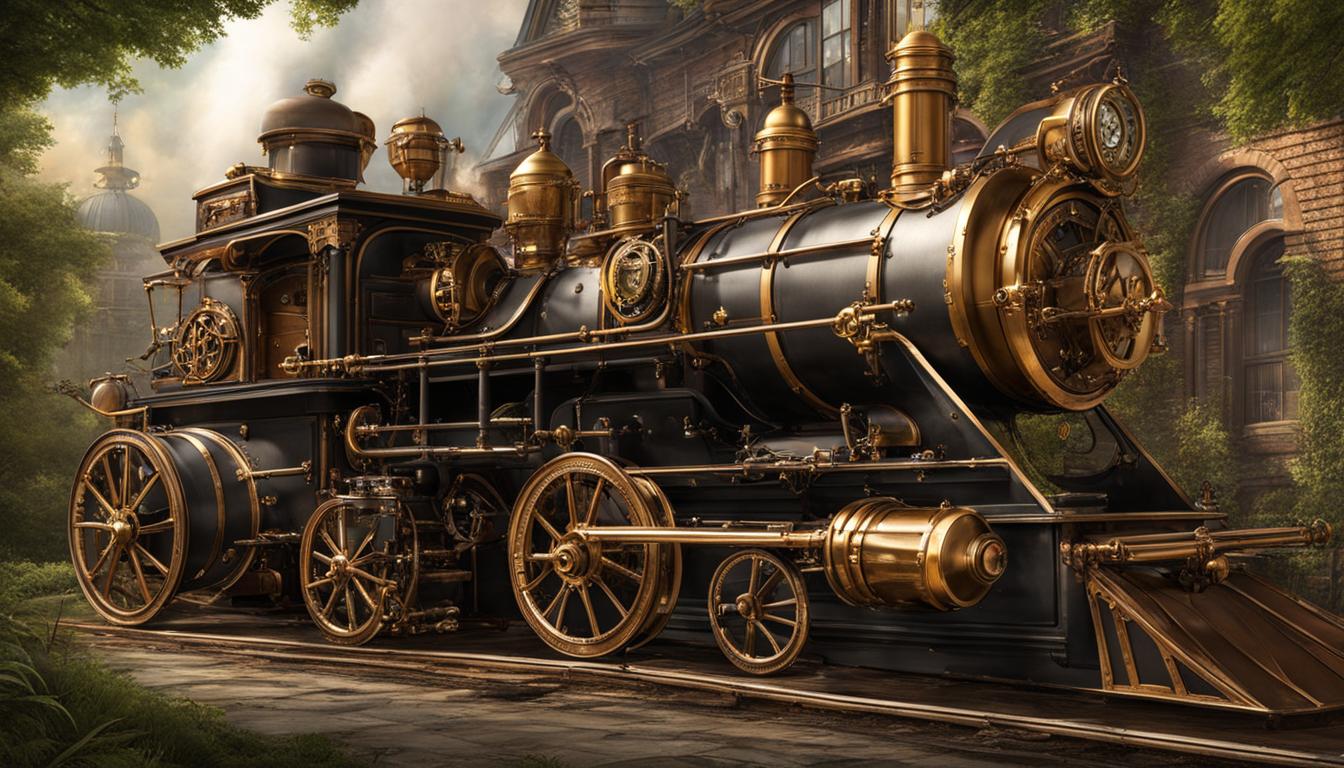The Steampunk subculture is more than just a fashion or aesthetic movement; it embodies a unique worldview with its own set of ideals and visions. Steampunk explores alternative histories, imagining a world where steam technology is prominent and Victorian-era sensibilities intersect with futuristic ideas. It challenges the mainstream culture and its reliance on consumerism, while advocating for self-expression, creativity, and community. By delving into the core beliefs of the steampunk worldview, we can gain a deeper understanding of its societal views, interpretation of the past, and vision for the future.
Key Takeaways:
- Steampunk is more than just a fashion trend, it represents a unique worldview.
- Steampunk delves into alternative histories, merging Victorian sensibilities with futuristic concepts.
- The subculture challenges mainstream culture and promotes self-expression, creativity, and community.
- Understanding the steampunk worldview provides insights into its societal views and vision for the future.
- Steampunk encourages exploration of the past, present, and future through its unique lens.
Steampunk as a New Romantic Movement
The world of steampunk goes beyond just fashion and aesthetics. It is part of a larger movement, known as the New Romantic Movement, which challenges mainstream cultural norms and embraces a more personalized and interconnected worldview. Steampunk embodies this movement by seeking a holistic balance between technology and ecology, emphasizing sustainability, creativity, and inclusivity.
In the steampunk community, craftsmanship and repurposing are highly valued. People come together to create intricate gadgets and elaborate costumes, showcasing their creativity and skill. This emphasis on DIY culture and community aligns with the values of the New Romantic Movement, which aims to break away from the consumer-driven society and foster a sense of connection and self-expression.
“Steampunk invites us to imagine a world where Victorian-era sensibilities intertwine with futuristic ideas, where steam-powered technology reigns supreme, and where individuality and creativity thrive. It challenges us to rethink our relationship with technology and the environment, urging us to find a harmonious balance between the two.”
Steampunk as a New Romantic Movement
Steampunk can be seen as a reflection of the growing desire for a more sustainable and interconnected future. Its focus on craftsmanship, repurposing, and community-building resonates with individuals who see the value in fostering a more heartfelt and authentic way of life. By embracing the principles of the New Romantic Movement, steampunk offers a potential shift in humanity’s worldview, promoting a more balanced and harmonious relationship between technology and the environment.
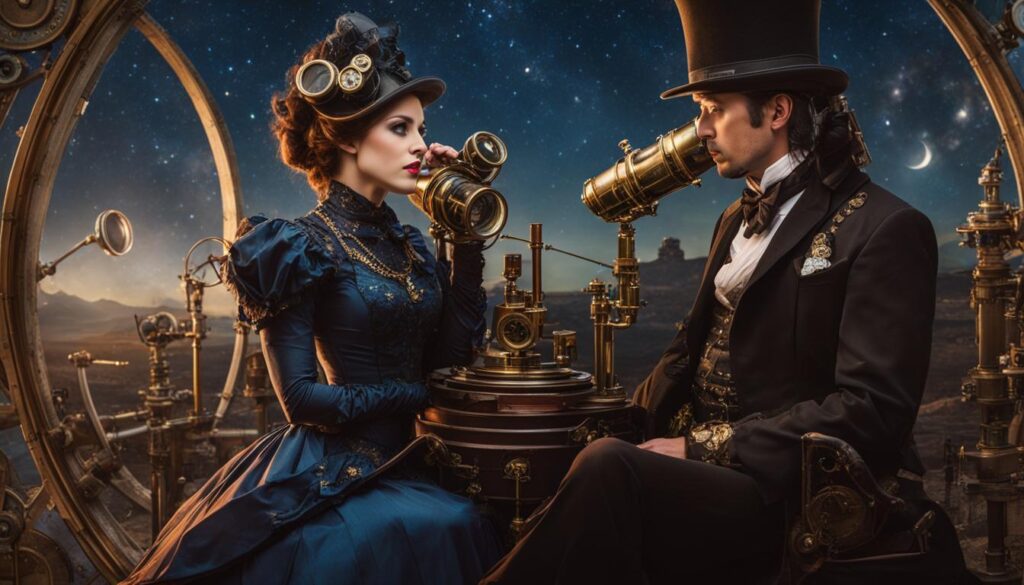
| Steampunk as a New Romantic Movement | Main Characteristics |
|---|---|
| Creativity and Self-Expression | Steampunk encourages individuals to express themselves creatively, whether through art, fashion, or invention. |
| Community and Collaboration | Steampunk fosters a sense of community and collaboration, where like-minded individuals come together to share ideas and create immersive experiences. |
| Sustainability and Repurposing | Steampunk promotes sustainable practices and repurposing of materials, allowing for a more eco-friendly approach to creativity and innovation. |
| Inclusivity and Acceptance | Steampunk embraces diversity and welcomes individuals from all walks of life, creating a space where everyone can be themselves without judgment. |
Exploring the Phenomenon of Steampunk
Steampunk has soared in popularity, captivating the imagination of intelligent and creative individuals from various walks of life. Contrary to the notion that cosplay and fandom are solely for those disconnected from reality, research shows that most cosplayers, including steampunk enthusiasts, are highly functional and successful in their daily lives. This thriving subculture has experienced significant growth, with a strong appeal that extends beyond the realm of escapism.
The allure of steampunk lies in its emphasis on creativity, self-expression, and the fusion of beauty and technology. It offers a unique platform for individuals to showcase their ingenuity and craftsmanship, creating intricate costumes and gadgets that combine elements of the past and the future. Steampunk enthusiasts are drawn to the aesthetic qualities of the subculture, as well as the opportunity to challenge mainstream culture by embracing alternative histories and reimagining societal norms.
Steampunk’s ability to attract intelligent and creative individuals can be attributed to its inherent values and principles. It provides a space for innovation, encouraging individuals to think outside the box and push the boundaries of what is possible. By celebrating the marriage of artistry and technology, steampunk offers a refreshing departure from the mundane, inspiring its followers to explore new avenues of self-expression and engage in imaginative storytelling.
| Table: Key Factors Contributing to Steampunk’s Appeal |
|---|
| Creativity and Self-Expression |
| Steampunk allows individuals to showcase their creativity through intricate costumes, gadgets, and storytelling. |
| Fusion of Beauty and Technology |
| Steampunk combines the aesthetics of the past with imaginative and fantastical technology, creating a visually stunning and captivating world. |
| Challenging Mainstream Culture |
| Steampunk offers an alternative to mainstream culture, embracing unique histories and reimagining societal norms. |
| Innovation and Ingenuity |
| Steampunk encourages individuals to think outside the box, fostering innovation and pushing the boundaries of what is possible. |
As steampunk continues to captivate the hearts and minds of individuals around the world, its growth and popularity show no signs of slowing down. This subculture has become a haven for those seeking an alternative to the mainstream, attracting intelligent and creative individuals who embrace self-expression, challenge societal norms, and revel in the fusion of beauty and technology.
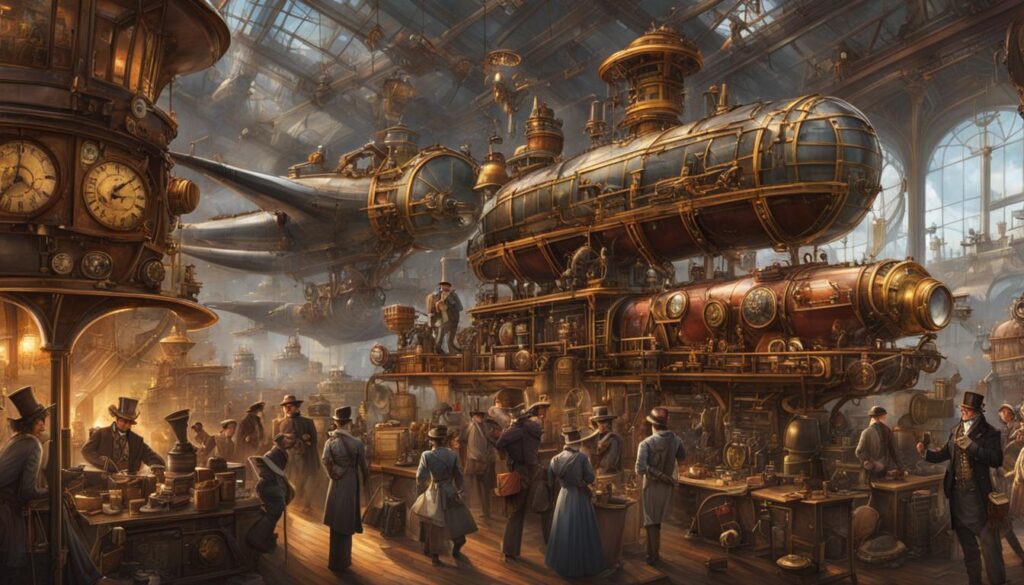
Unraveling the Mystery: What is Steampunk?
Defining steampunk can be a challenging task, as it encompasses various aspects that intertwine to create a unique subculture. Steampunk is often described as a literary sub-genre of science fiction, drawing inspiration from the 18th century. It combines the aesthetics of the Victorian era with imaginative and fantastical technology, creating a world where steam-powered machinery dominates. However, steampunk is not limited to literature; it has also evolved into an artistic subculture that embraces craftsmanship, self-expression, and creativity.
Steampunk enthusiasts are known for their DIY ethos, where individuals create their own costumes, gadgets, and events. This allows for a high degree of personalization and self-expression, making every steampunk creation as unique as the individual behind it. The emphasis on repurposing and upcycling materials also aligns with a focus on sustainability and environmental consciousness.
“Steampunk is not just a fashion trend or a passing fad. It is a movement of individuals who challenge conventional norms and embrace their creativity, resulting in a vibrant and inclusive community.” – Steampunk enthusiast
Steampunk’s literary sub-genre has deep roots in the works of renowned authors like Jules Verne and H.G. Wells. Their imaginative portrayals of futuristic technologies from a time before mass production laid the foundation for the steampunk aesthetic and themes. The combination of history and fantasy in steampunk allows for the exploration of alternative histories, diverging from real events while staying grounded in the knowledge of what actually occurred.
The Steampunk Subculture in Numbers:
| Statistic | Value |
|---|---|
| Number of active steampunk conventions worldwide | 50+ |
| Annual revenue generated by the steampunk industry | $300 million+ |
| Percentage of steampunk enthusiasts who engage in DIY projects | 80% |
| Number of online communities dedicated to steampunk | 1000+ |
Steampunk’s artistic subculture has grown in popularity, attracting a diverse range of individuals who are drawn to its unique blend of history, fantasy, and creativity. Whether through literature, fashion, art, or events, steampunk continues to captivate the imagination and inspire individuals to explore their own visions of a steam-powered world.
The Origins and Influences of Steampunk
Steampunk, as a subgenre and artistic subculture, draws its roots from various sources, with notable influences from authors like Jules Verne and H.G. Wells. These visionary writers depicted fantastical technologies and alternative worlds, providing the foundation for the Steampunk aesthetic and themes that we see today. Inspired by their works, Steampunk combines elements of the Victorian era and the Industrial Revolution, imagining a world where steam-powered machinery and intricate clockwork devices dominate.

The Literary Influence: Jules Verne and H.G. Wells
“What one man can invent, another can discover.” – Sherlock Holmes, The Adventure of the Dancing Men
Jules Verne’s novels like “20,000 Leagues Under the Sea” and “Around the World in Eighty Days” showcased futuristic technology and exploration, inspiring the concept of technological innovation in Steampunk. H.G. Wells, on the other hand, presented works like “The Time Machine” and “The War of the Worlds,” which explored themes of time travel and extraterrestrial encounters, sparking the imagination of Steampunk enthusiasts.
Victorian Nostalgia and Industrial Revolution
The Victorian era, known for its intricate fashion, elegance, and strict social hierarchy, plays a significant role in shaping the Steampunk aesthetic. The Industrial Revolution, with its rapid advancements in steam-powered machinery and transportation, provides the technological foundation for the Steampunk world. This fusion of historical elements and futuristic visions sets the stage for Steampunk’s unique worldview and creative expression.
Steampunk’s Themes and Social Commentary
Steampunk, as a genre and subculture, delves into a rich tapestry of themes that encompass rebellion, innovation, and social reform. In the realm of steampunk, characters often challenge conventional norms and societal structures, embodying a spirit of resistance against oppressive regimes. This rebellious streak is a cornerstone of the steampunk aesthetic, reflecting a desire for individual freedom and a rejection of conformity.
Moreover, steampunk is characterized by its focus on innovation. The subgenre celebrates human creativity and ingenuity through the depiction of imaginative inventions and technological advancements. The fusion of beauty and technology in steampunk creations showcases the relentless pursuit of progress and the desire to push the boundaries of what is possible.
“Steampunk is not just about dressing up in Victorian garb; it’s about exploring the possibilities of the past meeting the future, and using that exploration as a reflection of our own society.”
– SteamEnthusiast Magazine
Steampunk serves as a canvas for social commentary, addressing issues such as equality, justice, and societal disparities. It draws inspiration from the struggles of the Victorian era and contemporary concerns, offering a lens through which to examine and critique both historical and modern societies. By reimagining the past and infusing it with futuristic elements, steampunk opens up dialogue about the consequences of societal structures and challenges the status quo.
The Rebellion in Steampunk
At the heart of steampunk lies a spirit of rebellion against oppressive systems and a desire for individual agency. Characters in steampunk often act as catalysts for change, defying societal expectations and challenging the established order. Whether it’s a group of airship pirates fighting against an authoritarian regime or an inventor breaking free from societal constraints, rebellion is a recurring theme that underscores the genre.
Steampunk’s Focus on Innovation
Central to the steampunk ethos is a celebration of innovation and the pursuit of progress. Steampunk creations showcase intricate and imaginative gadgets, machinery, and inventions that transcend the technological limitations of the Victorian era. This focus on innovation reflects a belief in the power of human ingenuity and the desire to push the boundaries of what is possible.
Steampunk as a Reflection of Social Reform
Steampunk goes beyond surface aesthetics and delves into deeper societal issues. By exploring themes of social reform, steampunk encourages discussions around equality, justice, and the consequences of power structures. It provides a platform to challenge and reimagine societal norms, serving as a reflection of societal struggles and a call for positive change.

The Importance of Research in Steampunk Storytelling
Crafting a believable and immersive Steampunk story requires extensive research. Authors need to delve into the historical context of the Victorian era, understanding the social dynamics, cultural norms, and technological advancements of the time. Research helps create historical authenticity, incorporating real historical figures, events, and locations seamlessly into the narrative. It also aids in exploring technological innovation, designing imaginative and intricate devices within the world of Steampunk. Additionally, research enables the exploration of alternative histories, diverging from real events while staying grounded in the knowledge of what actually occurred.
Steampunk storytellers must immerse themselves in the aesthetics, technology, and societal norms of the Victorian era. By conducting thorough research, writers can develop a deep understanding of the fashion, architecture, and industrial innovations that characterized the time period. This knowledge allows for the creation of rich and vivid descriptions, bringing the Steampunk world to life for readers.
The historical accuracy achieved through research adds credibility to Steampunk storytelling. It enhances the reader’s immersion in the narrative and fosters a sense of realism, even in a fantastical setting. From the politics of the era to the intricate workings of steam-powered devices, the attention to detail derived from research enriches the storytelling experience.
| Research Benefits in Steampunk Storytelling | Research Methods |
|---|---|
| Enhances historical authenticity | Reading historical books and manuscripts |
| Aids in technological innovation | Exploring scientific advancements of the era |
| Enables the creation of alternative histories | Studying divergent historical perspectives |
| Fosters rich and vivid descriptions | Immersing in the art, fashion, and architecture of the time |
| Heightens reader immersion | Attending living history events and museums |
“Research is the backbone of Steampunk storytelling. By delving into the historical context and technological advancements of the Victorian era, authors can create a believable and immersive world that captivates readers. It allows for the integration of real historical events and figures seamlessly into the narrative, lending authenticity to the story. Whether it’s exploring alternative histories or designing intricate steam-powered contraptions, research is essential for creating a compelling Steampunk tale.” – Steampunk author Jane Powers
Conclusion
Steampunk is not just a passing trend or a mere fashion movement; it represents a profound cultural shift. This subculture challenges the mainstream by advocating for self-expression, creativity, and community, while simultaneously reimagining history with its fusion of past and future. Steampunk’s emphasis on craftsmanship, repurposing, and sustainability aligns perfectly with the values of the emerging New Romantic Movement.
With its unique perspective and ideals, steampunk has the potential to inspire innovation, redefine societal norms, and even save western culture from its current challenges. By encouraging individuality and celebrating imagination, this subculture provides a platform for creativity, inclusivity, and cultural transformation. However, to maintain its authenticity and integrity, it is crucial for steampunk to avoid being co-opted by mass market forces.
Steampunk serves as a symbol of cultural change, offering an alternative to the prevailing consumerist culture. Its forward-thinking fusion of Victorian aesthetics and futuristic technology sparks the imagination and rekindles a sense of wonder. By embracing the values of self-expression, craftsmanship, and sustainable practices, steampunk has the power to shape a brighter future.
As the steampunk movement continues to grow, it is important to preserve its unique spirit and ensure that it remains a haven for creativity and cultural exploration. By staying true to its roots and forging new paths, steampunk can make a lasting impact on society, inspiring individuals to think differently, embrace their creativity, and unite in the pursuit of a better future.
FAQ
What is the Steampunk subculture?
The Steampunk subculture is more than just a fashion or aesthetic movement; it embodies a unique worldview with its own set of ideals and visions.
How does Steampunk challenge mainstream culture?
Steampunk challenges mainstream culture by advocating for self-expression, creativity, and community, while questioning the reliance on consumerism.
Who is attracted to the Steampunk subculture?
Steampunk attracts intelligent and creative individuals who seek an alternative to mainstream culture, drawn to its emphasis on creativity, self-expression, and fusion of beauty and technology.
How is Steampunk defined?
Defining Steampunk can be challenging, as it encompasses various aspects, including a literary sub-genre of science fiction, an artistic subculture, and even a socio-political anti-consumerist movement.
What are the roots of Steampunk?
Steampunk has its roots in the works of authors like Jules Verne, H.G. Wells, and Mary Shelley, who depicted fantastic technologies from a time before mass production.
What themes does Steampunk explore?
Steampunk explores themes such as rebellion, innovation, and social reform, often portraying characters challenging conventional norms and celebrating human creativity.
How important is research in Steampunk storytelling?
Research is crucial in crafting a believable and immersive Steampunk story, providing historical authenticity, exploring technological innovation, and enabling the exploration of alternative histories.
What does Steampunk symbolize?
Steampunk symbolizes a larger cultural shift, challenging mainstream culture while advocating for self-expression, creativity, and community, with the potential to inspire innovation and redefine societal norms.

